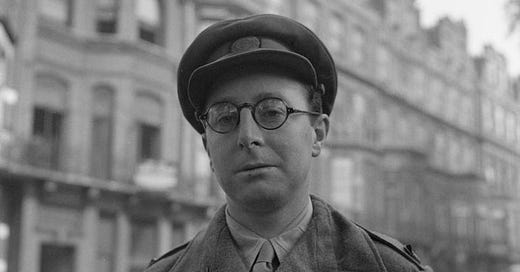Leonard Mosley parachuted into Normandy with a typewriter
By the time Leonard Mosley jumped out of an RAF transport plane just after 1 a.m. on June 6, 1944 and floated into Normandy with a typewriter strapped to his chest, he had been working as a journalist nearly half his life and had published six books — including an autobiography released before he had even turned 25.
This was not a man to shy away from the spotlight, and D-Day was the biggest stage yet for the Kemsley Newspapers war correspondent. Mosley’s remarkable 2,000-word account of his drop into the action with the British 6th Airborne would run in newspapers worldwide and stand as a highlight in his 50-year writing career.
Born Feb. 11, 1913 in Manchester, England, Mosley began working at newspapers as a teenager and was well-traveled before the war, spending more than a year working in the United States in the early 1930s. By the summer of 1944 he was covering the war for the Kemsley chain, including the Daily Telegraph and the Daily Sketch. But his D-Day story ran everywhere under the terms of the pool agreement in place for the opening days of Operation Overlord.
The British and American versions are slightly different, but this is the way readers in his home nation were introduced to Mosley’s D-Day experience:
This is one of those stories that will have to write itself, because I am too exhausted, excited and exhilarated to have any control over what goes down on this typewriter. I parachuted into Europe two minutes past 1 a.m. this morning, six-and-a-half hours before our seaborne forces began the full-blown invasion of Festung Europa, and I have seen, done and experienced a lot since then.
The story traced Mosley's progress, from boarding the plane "C for Charlie" at a British airfield at 11:20 p.m. on June 5 through his harrowing landing in France and the tense moments and hours that followed as he worked his way toward the coast.
As dawn came I moved across country through Nazi patrols to get nearer to the coast. Wherever we moved there were traces of our airbourne invasion. Emptied containers, still burning their signal lights, were scattered in fields and orchards, wrecked gliders littered the ground, some of them splintered to matchwood. There were parachutes lying everywhere.
There was an earthshaking holocaust of noise. Approaching the coast under cover of naval ships the invasion barges were coming in and coming in firing. It was a terrific barrage that must have paralysed the defenses. Then ships began nudging towards the beaches and we shook each others' hands in the knowledge that the invasion, at long last, had begun.
Mosley's report wraps up shortly after 9 p.m. on June 6, with another fleet of gliders coming in to reinforce the airborne troops who had landed nearly 24 hours earlier. An unnamed general assures him that everything is going to plan, and Mosley concludes: "It still is, as I finish this dispatch. We are confident it will continue to go according to plan."
Even amid the avalanche of reporting produced around D-Day, Mosley’s dispatch caught the attention of his peers. William Johnson of Time magazine’s London bureau cabled the home office back in the U.S. about the story, calling it “by far the most vivid eyewitness report published here thus far.”
Mosley would remain in journalism after the war, initially serving as a film and theater critic, before turning his focus to writing novels and biographies in the 1950s. Among his subjects: Emperor Hirohito, George C. Marshall, Charles Lindbergh, Hermann Goering and Walt Disney.
Mosley spent the latter decades of his life mostly in Nice, where he died in June 1992 at age 79.




